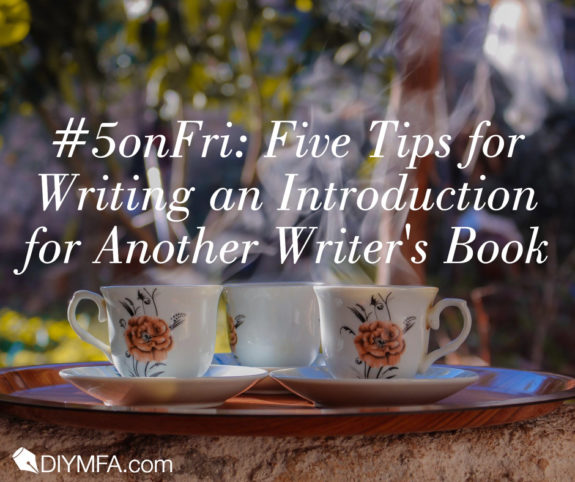Last summer, Alison Walsh from the literary food blog Alison’s Wonderland Recipes sent me a surprising invitation: To write the introduction for her then-upcoming cookbook, A Literary Tea Party. It was an offer I couldn’t refuse. First, it meant having a byline in a published book—and what writer wouldn’t be excited about that? Second, it would give me the chance to contribute to a book I was already looking forward to, since I already knew about Alison’s book deal.
Writing an introduction for someone else’s book, however, is not without its challenges. You might wonder what the author’s or publisher’s expectations might be, what you should actually write, or whether you’re “qualified” for the task. So if you’re ever asked to contribute to a book in this way, here are five tips to keep in mind.
1) Ask for the author’s and/or publisher’s requirements
It’s important to know what the author and their publisher are looking for before you write your introduction. So in your initial correspondence, ask questions that will establish the ground rules. For example, what is the recommended word count? When is the deadline for submitting the introduction, and to whom? Most importantly, what are the other parties looking for in terms of content? In my case, I posed these questions to Alison, who then passed them on to her editor and ensured I received answers in a timely manner. Also, since my deadline coincided with Alison’s deadline for submitting her manuscript, I made sure to submit my introduction before that date to avoid delays on my end.
2) Make sure you’re familiar with the book’s contents
Writing an introduction requires you to be familiar with the subject matter as well as the book’s specific contents. You don’t need to read every word of the manuscript or go in depth about its chapters. Instead, ask the author if they can send you select pages or sections that are important, a table of contents, or other materials for the project that can guide you in writing an introduction that is informative, fits the book’s “personality,” and avoids redundancy. You may also need to do additional research on the topic or the author as needed.
Being a follower of Alison’s blog, I was already familiar with its niche (recipes for foods inspired by classic literature) and the cookbook’s twist on that niche (literary-inspired dishes for tea parties). So for my research, I revisited Wonderland Recipes and reviewed several recipes, Alison’s blog updates on her publishing journey, and some of the fangirling—I mean, enthusiasm—in comments that Alison and I had exchanged about books and tea. Alison also shared information with me about A Literary Tea Party, including her introduction text for each section.
As a result, I developed a better understanding of the cookbook’s structure and delightfully nostalgic tone as well as which stories and recipes would be highlighted. This informed how I should write my introduction and what supporting or personal examples I could include that would be appropriate but not repetitive.
3) Study the introductions of similar books you’ve read
It often helps to study what other writers have done so you can see how they approached the same project and determine how to make yours unique. So before writing your introduction, read introductions for published books in the same or similar genre that you’ll be writing for. How does each writer begin their piece? How do they end it? What kinds of examples do they use? What else do you notice about each introduction? These were all things I considered while reading introductions and forewords in cookbooks and creative nonfiction books I own, including:
- The All New Good Housekeeping Cook Book (introduction by former Good Housekeeping editor Ellen Levine)
- So Easy: Luscious, Healthy Recipes for Every Meal of the Week (cookbook and introduction by Ellie Krieger)
- Gift from the Sea (written by Anne Morrow Lindbergh, introduction by her daughter Reeve Lindbergh)
- DIY MFA: Write with Focus, Read with Purpose, Build Your Community (written by Gabriela Pereira, introduction by Jacquelyn Mitchard—because, hey, why not? *wink*)
4) Demonstrate your knowledge of the book’s topic and your connection to the author
When brainstorming for your introduction, put yourself in the shoes of a potential reader and ask what you would look for in the introduction that could persuade you to keep reading. You can break this down further into questions such as:
- What examples can I include (either from research or personal experience) to show my knowledge on this subject?
- How has this subject impacted my life? How could it impact the lives of prospective readers?
- How can I summarize this book in one paragraph, and in my own words?
- How can I briefly explain my connection to this book and/or the author?
- What else can I say to entice the reader to keep reading?
With A Literary Tea Party, I started with a question: “Why do food and drink appear so often in great stories?” This question is integral to the cookbook’s paired topics and compels the reader to consider why this pairing makes sense. Plus, it created a natural path to other points I wanted to make: concise examples of food in literature and their significance, my love of reading (and my frequent habit of drinking tea while reading), and finally to the cookbook itself. I also briefly explained how Alison and I knew each other so readers would understand my personal connection to the cookbook and the author.
5) Overcome your sense of “Imposter Syndrome”
You know those moments when you feel like a fraud? When you’re convinced your writing isn’t good enough or your name isn’t well-known from your perspective, and other people will judge you for it? This is imposter syndrome in full force—and you bet I had a strong case of it with A Literary Tea Party. Even though I was thrilled to be writing the introduction, at times I still thought, “I’m not a published author. Yes, I’ve had plenty of other experiences as a writer, but do they make me qualified enough for this?” And once the cookbook was published, I wasn’t sure if, since I was “only the introduction writer,” I had as much reason to openly celebrate its release as Alison did.
Maybe you’ll feel the same way if you’re asked to write an introduction for another writer’s book. If you do, take a moment to consider your accomplishments thus far as a writer, your past and current writing projects, and any related experiences. Then see how they align with this latest task. Chances are you’ll discover that, yes, you are qualified enough. The author and the publisher clearly believe you’re the best candidate—that’s why they asked you in the first place.
So go ahead. Say “yes,” and write that introduction. Then, once the book is out in the world, celebrate its arrival as enthusiastically as the author does. You might end up persuading other people who might not have otherwise heard of the book to buy it.
Have you ever been asked to write the introduction of another writer’s book, or to contribute something similar to their project? What are some of your favorite introductions to books you’ve read? How did they convince you to keep reading?
 Sara Letourneau is a speculative fiction writer and poet in Massachusetts who devours good books, loves all kinds of music, and drinks copious amounts of tea. In addition to writing for DIY MFA, she was previously a Resident Writing Coach at Writers Helping Writers and a freelance tea reviewer and music journalist. Her poetry is forthcoming or has appeared in Muddy River Poetry Review, Canary, Soul-Lit, The Eunoia Review, Underground Voices, and elsewhere. Visit Sara at her personal blog, Twitter, and Goodreads.
Sara Letourneau is a speculative fiction writer and poet in Massachusetts who devours good books, loves all kinds of music, and drinks copious amounts of tea. In addition to writing for DIY MFA, she was previously a Resident Writing Coach at Writers Helping Writers and a freelance tea reviewer and music journalist. Her poetry is forthcoming or has appeared in Muddy River Poetry Review, Canary, Soul-Lit, The Eunoia Review, Underground Voices, and elsewhere. Visit Sara at her personal blog, Twitter, and Goodreads.







